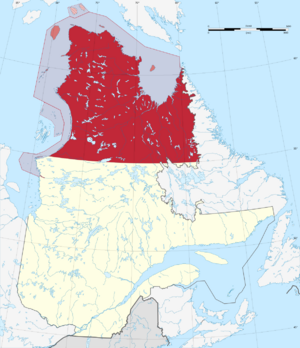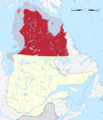Zebedee Nungak facts for kids
Quick facts for kids
Zebedee Nungak
|
|
|---|---|
| ᔭᐃᐱᑎ ᓄᓐᖓᖅ | |
| Born |
Jabedee Noongoak
23 April 1951 Saputiligait, Quebec, Canada
|
| Political party | Independent |
| Awards | National Order of Quebec |
Zebedee Nungak (born April 23, 1951) is an important Inuk leader from Canada. He is an author, actor, journalist, and politician. When he was a child, Nungak was part of a special program by the Canadian government. This program aimed to teach Inuit children a "southern way of thinking."
Zebedee Nungak later played a big role in getting land rights for his people. He helped create Nunavik, which is the Inuit territory in northern Quebec. He has worked hard to make sure Inuit rights are recognized and respected.
Contents
Early Life and the "Eskimo Experiment"
Zebedee Nungak was born in a small village called Saputiligait in Nunavik, Quebec, on April 23, 1951. His birth name was Jabedee Noongoak. He was one of seven children in his family.
The "Eskimo Experiment"
When Nungak was 12 years old, in 1963, he was chosen for a program called the "Eskimo Experiment." The Canadian government started this program. Its goal was to have Inuit children finish high school in southern Canada. Nungak and two other boys, Peter Ittinuar and Eric Tagoona, were chosen. They were taken from their homes without their families' full permission. They lived with English-speaking families in Ottawa.
Nungak went to three different schools in Ottawa. He and the other boys were good at sports like judo and swimming. They even appeared on the cover of Judo World magazine in 1964.
Even though he was far from home, Nungak said he had "nothing bad to say about anybody" during this time. However, being away from his community had challenges. He missed important family events, like the birth of his youngest sister and his grandmother's death. He also found it hard to fit in when he returned home. He had lost some important skills that other Inuit in his community had learned.
The government's goal for this experiment was to see if Inuit children had the same intelligence as non-Inuit children. They also wanted to "expunge them of Inuit culture." This meant trying to remove their Inuit ways of life. The government knew this program might harm family ties and Inuit culture. A film called The Experimental Eskimos was made in 2009 about their experiences.
Career and Leadership
After their time in the experiment, Nungak and Ittinuar realized they understood both northern and southern ways of life. Nungak decided to work for the government. His goal was to help Inuit people govern themselves. At 19, he became a translator and interpreter. He returned to his home community in the 1970s. He also worked as an editor for a newsletter and as a broadcaster for CBC North. Nungak has said he has worked with prime ministers and other leaders throughout his career.
Zebedee Nungak was a key figure in creating Nunavik. This is the Inuit region in northern Quebec. In 1972, he helped start the Northern Quebec Inuit Association (NQIA). He was its secretary-treasurer. This group worked with the Grand Council of the Crees. They negotiated with the governments of Quebec and Canada. This led to the first land claim agreement for the Inuit.
Nungak was one of the people who signed the James Bay and Northern Quebec Agreement in 1975. This agreement was very important for Inuit rights. He also managed Saputik, an organization that held Inuit lands in Quebec.
From 1984 to 1987, Nungak helped lead the Inuit Committee on National Issues. They worked to make sure Inuit rights were included in the Canadian constitution. Later, from 1995 to 1998, he was the president of the Makivik Corporation. This organization manages money from the land claim agreement.
Writing and Journalism
Nungak is a talented writer and journalist. He has written many articles for different magazines. He speaks English, French, and Inuktitut. He has published books in all three languages. His writings often focus on keeping Inuit stories alive. He also works to raise awareness about protecting Inuit languages.
Nungak has collected stories from his community. He has also published books about the discussions of Inuit elders. One of his books, Illirijavut. ᐃᓪᓕᕆᔭᕗᑦ. That which we treasure. La langue que nous chérissons, helps to bring back the Inuktitut language. He has traveled around Nunavik to check on the state of the Inuktitut language. He also created a plan to help preserve it.
Nungak strongly supports keeping Inuit language and culture alive. He hosts a competitive Inuktitut word game called Uvangaqqaaq ('Me First'). He jokes that he is "the Alex Trebek of the North." One of his unique ideas is "Qallunology." This is a fictional study where Inuit people study white people (called Qallunaat). This idea is shown in the documentary Qallunaat! Why White People Are Funny, which he helped direct.
Political Views
Nungak ran for federal and provincial political office twice. He was openly against the Quebec sovereignty movement. This movement wanted Quebec to become an independent country. Nungak worried that an independent Quebec would separate the Inuit of Nunavik from other Inuit in Canada. He also feared it would end Nunavik's special relationship with the Canadian government.
He believed that even though Inuit people are a smaller group, their land is very important. He said, "Well, it may be true that our numbers are inconsequential but the land we tread—where we have had our homes for thousands of years—is not inconsequential at all." As president of the Makivik Corporation, he traveled to places like Brussels and London. He spoke out against Quebec becoming independent. He also served as a councillor for the community of Kangirsuk.
Awards and Recognition
In 2017, Zebedee Nungak received the National Order of Quebec. This is a high honor given by the Premier of Quebec. He was recognized for his important contributions to Quebec society. He received the Knight insignia.
In 2021, Nungak was given the First Peoples' Medal by the Lieutenant Governor of Quebec. This award honors people who have made great contributions to their communities.
Personal Life
Zebedee Nungak lives in Kangirsuk with his wife and seven children. He continues to work as a cultural commentator. He also works for the Avataq Cultural Institute on language preservation. Nungak enjoys playing the accordion.
Images for kids





